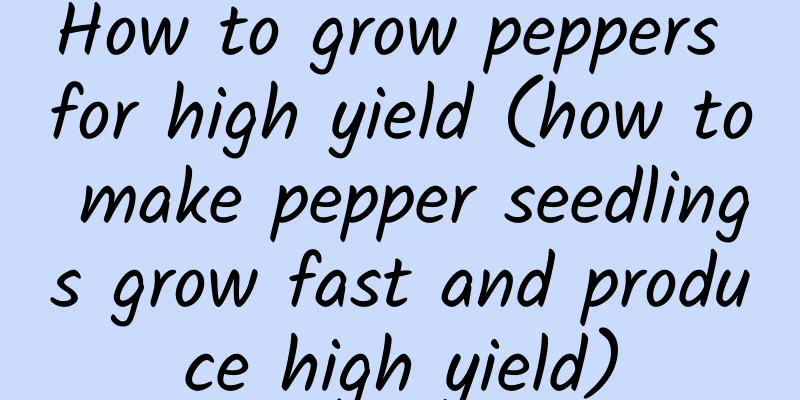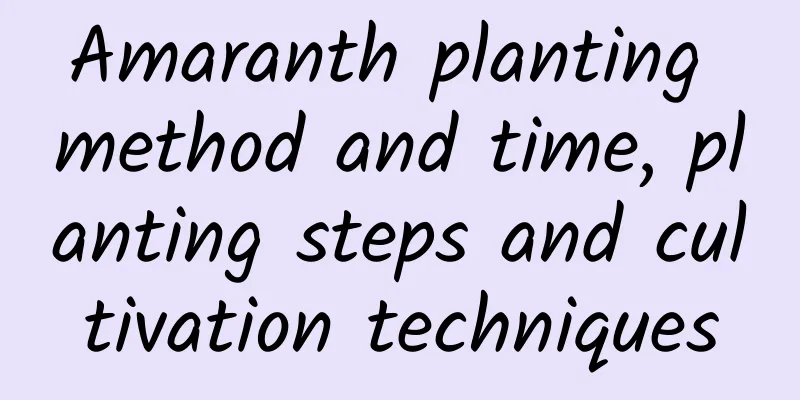How to grow peppers for high yield (how to make pepper seedlings grow fast and produce high yield)

|
Chili can be eaten directly or used as a condiment, and has certain value. Therefore, the demand for chili is gradually increasing in the market, and increasing the yield of chili has become an important goal of the current chili industry. 1. Variety selectionChoose suitable varieties according to local natural environment conditions. 2. Seedling cultivationCultivating strong seedlings of the right age is one of the main measures for early maturity and high yield of peppers. The standard for strong seedlings is that the seedlings have many roots, are white, have thick stems, short internodes, are large and thick, have dark color, are not aged, do not grow too tall, and are free of diseases and insect pests. When sowing, choose fertile land with higher terrain, sheltered from the wind and facing the sun as the seedbed. The bed should be 1.2-1.5m wide. Sprinkle a layer of decomposed pig manure on the bed and spray it with 200-250 times diluted formalin or 500 times diluted 50% carbendazim for disinfection. Before sowing, water the seedbed thoroughly, mix the bud seeds with fine soil and stir evenly before sowing. After sowing, cover with 1 cm of fine soil and cover tightly with a film. In the evening, straw mats should be added to ensure that the night temperature is above 10°C. Generally, there is no ventilation before the seedlings emerge to facilitate germination. After the seedlings emerge, proper ventilation is required. 3. PlantingEarly planting at the right time to promote early rooting and early seedling emergence is the main principle of management during and after planting . During planting, cover with film and the planting period can be appropriately advanced. Generally, the seedlings can be transplanted when they are 10-15cm tall and have 6 true leaves. Water the seedbed thoroughly one day before transplanting and transplant with soil. The best seedlings for transplanting are those with short legs, thick stems, short nodes, upright and unbent growth, and dark green leaves. The root damage should be avoided, and the transplanting depth should be such that the cotyledons of the seedlings are level with the soil. Immediately after transplanting, water the plants sufficiently, or apply diluted manure water. When the weather is sunny or the temperature is high, water the plants several times in a row to help the seedlings grow. The safe transplanting period is when the daily average temperature stably exceeds 15°C. 4. Field ManagementAfter the peppers are planted, the air temperature and low temperature are still low, and the growth of the plants, especially the root system, is slow. Measures should be implemented to create conditions conducive to increasing the ground temperature. If the temperature is not too high, generally no watering or little watering is done, and inter-cultivation and loosening of the soil are done in time to loosen the soil surface, which is conducive to the growth of the root system and the aboveground part. Inter-cultivation can be combined with soil cultivation, which has a good effect on promoting root growth and preventing lodging, and is also convenient for irrigation and drainage. 5. Pest and disease controlThe main diseases that harm peppers include viral diseases, blight, anthracnose, bacterial angular leaf spot, etc. For viral diseases, you can spray plant disease-killing spirit, virus A, anti-virus alum and other drugs every 7 days before transplanting the seedlings and in the early stage of transplanting. Spraying 2-3 times in a row can reduce the probability of disease. Blight and anthracnose are fungal diseases. The control agents include 500 times diluted 40% ethylene phosphite aluminum wettable powder or 500 times diluted 25% metalaxyl sprayed on plants and ground surface to effectively prevent and control infection. Bacterial angular leaf spot is a bacterial disease, and the main drugs used are streptomycin sulfate, phytotoxin, etc. The main physiological diseases of peppers are flower and fruit drop, and the prevention and control measures are to appropriately add phosphorus fertilizer, intercrop with tall crops, and prevent and control diseases and pests in time. The main pests of peppers are cotton bollworms, aphids, red spiders, etc. Aphids and red spiders can be controlled by spraying with acetamiprid, pyridaben + avermectin, thiamethoxam and other pesticides; cotton bollworms can be sprayed with emamectin benzoate, Bacillus thuringiensis or pyrethroid emulsions. Intercropping a small amount of corn in the pepper field to lure the adult cotton bollworms to lay eggs, and then manually eliminating them will also have a certain effect. 6. Harvest at the right timePeppers should be harvested at the right time according to different uses. As fresh peppers, they are generally harvested about 30 days after flowering, when the fruit is fully grown, the skin is firm, the color is darker, and it is shiny, and the quality is good . As commercial dried peppers, they are generally harvested after the fruit is fully mature. |
>>: What is the reason for tomato fruit cracking?
Recommend
How to care for the newly bought mirror grass
1. Soil There is no need to change the pot or soi...
What is coffee?
What kind of crop is coffee? Coffee is a tropical...
Pros and Cons of Eve's Scented Garden Roses
Fragrant Garden is a rose variety introduced to C...
How to water camellia
Watering method When to water Camellia requires a...
Which month is suitable for planting Chinese toon in greenhouse?
When to plant Chinese toon in greenhouse Greenhou...
What to do if you water Strelitzia too much
Overwatering Strelitzia If the Strelitzia is wate...
The reason why the leaves of Japanese cypress turn yellow
1. Exposure to sunlight Reason: Juniper has requi...
A better grape variety than Sunshine Rose
1. Queen Nina Queen Nina grape, also known as Pri...
The growing environment and local conditions of walnut trees
Walnut Tree Growth Environment and Conditions Wal...
What is the difference between Anthurium and Flamingo?
Different origins: Anthurium is native to South A...
What to do if the domestic azalea wilts
1. Increase humidity Reason: We just moved the az...
Wanchongshan potted cultivation methods and precautions (Wanchongshan daily maintenance tips)
First, soil preparation and planting Wanchongshan...
How to grow Thousand Birds Flower
1. Maintenance methods 1. Temperature: The cold r...
How to care for Australian fir in four seasons
About Four Seasons Maintenance and Management 1. ...
How many kilograms of grapes are produced per acre
Grape yield per acre If the grapes are properly m...









